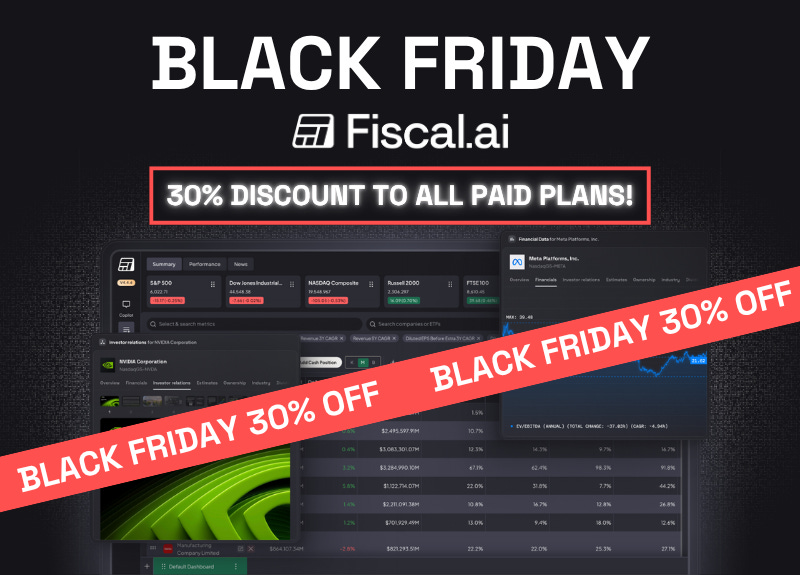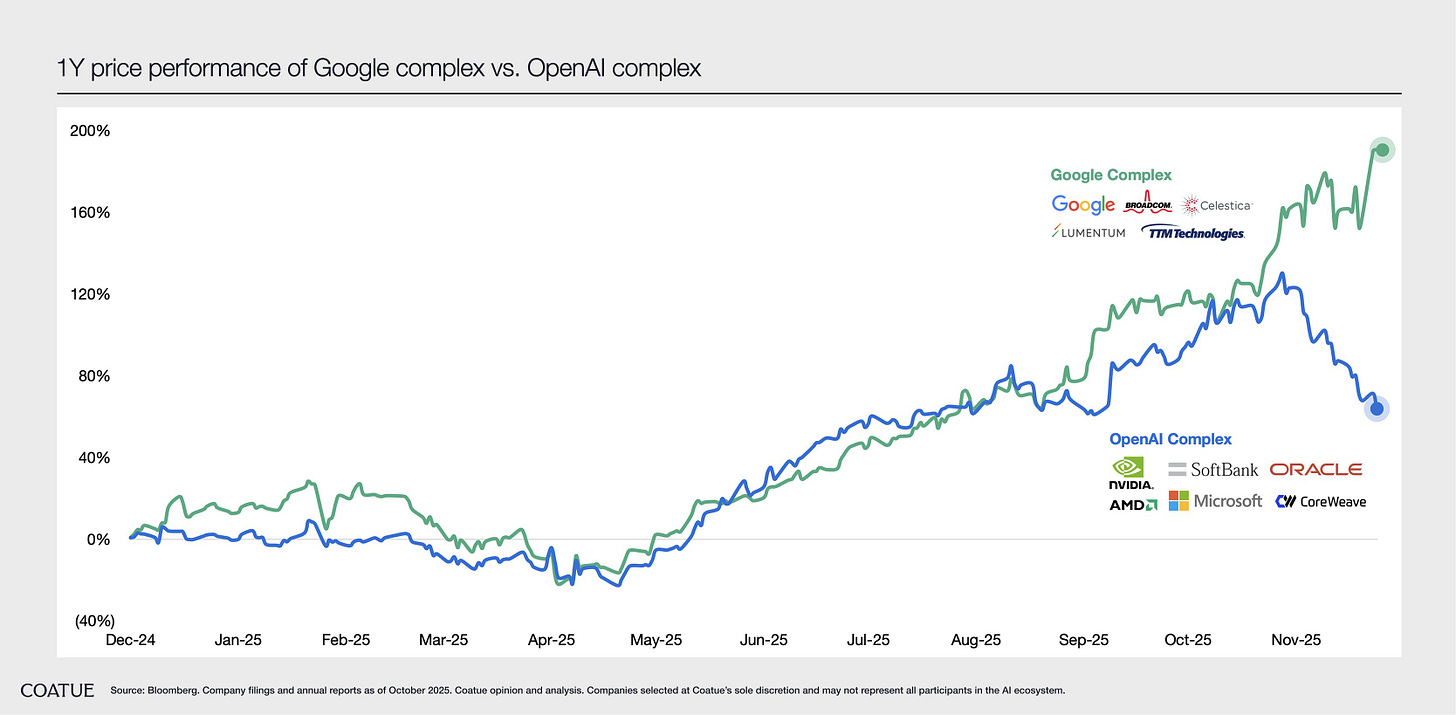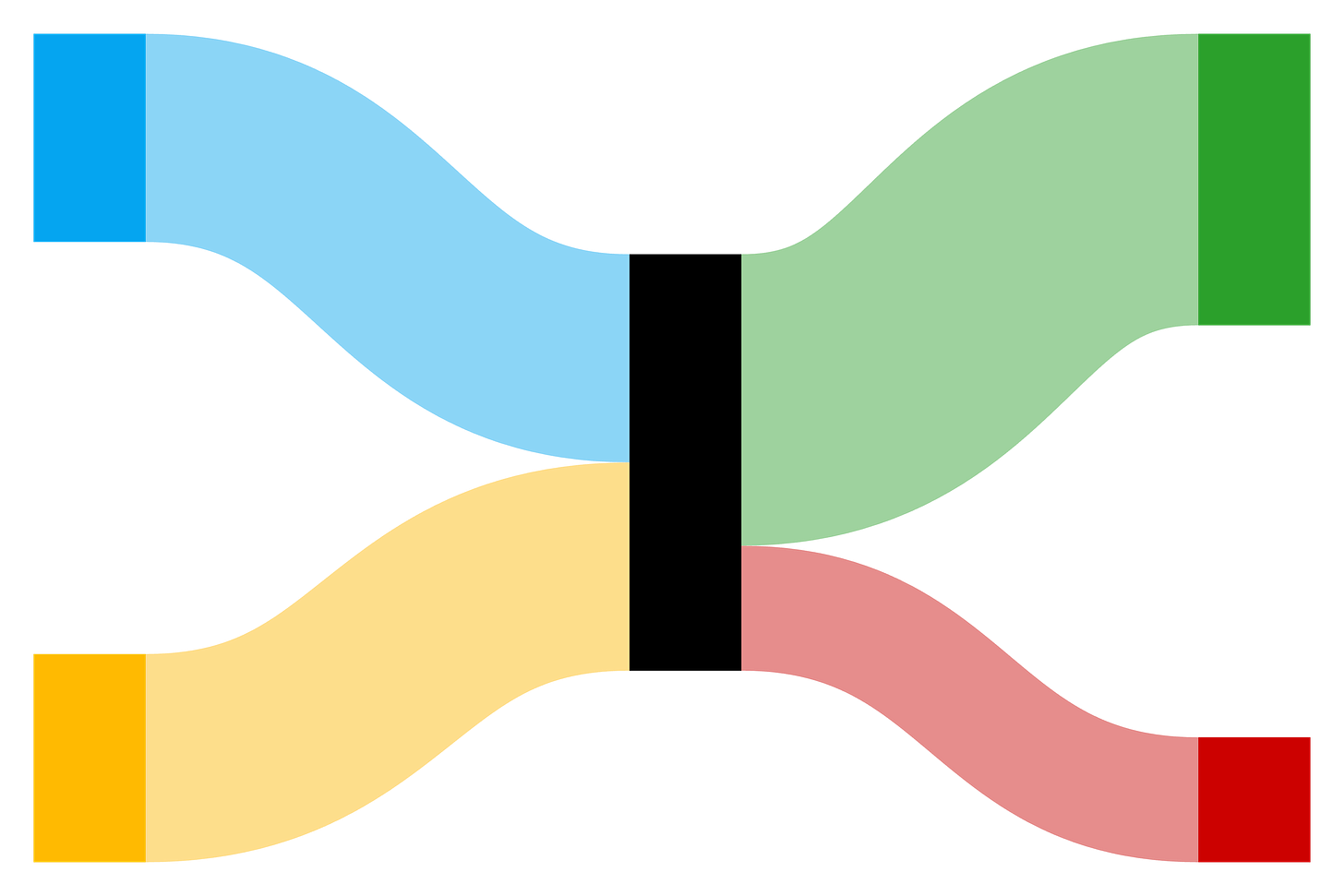💡 Insights You Might Have Missed
Abbott lands Exact Sciences and more AI bubble discussion
Welcome to the Free edition of How They Make Money.
Over 250,000 subscribers turn to us for business and investment insights.
In case you missed it:
FROM OUR PARTNERS
Fiscal.ai has a Black Friday offer for you
Fiscal.ai now powers my charts and financial data.
It’s my favorite place to research new stock ideas and visualize their performance:
Screeners.
Chart builder.
Portfolio tracker.
Earnings materials.
Side-by-side comparisons.
Quick fundamentals overlays.
You can select a specific company revenue segment or KPI and compare it across multiple companies. Your imagination is the only limiting factor!
Fiscal.ai is our data partner, so our readers already get 15% off their paid plans. And this Black Friday, you get an even larger discount of 30% off all their paid plans!
But don’t wait! The discount is only valid until Cyber Monday.
🧬 Abbott Lands Exact Sciences
Abbott Laboratories is a $220 billion medical device giant. But the company is far more than devices. Abbott also generates billions from diagnostics, nutrition, and established pharmaceuticals, making it one of the most diversified healthcare companies in the world.
Now Abbott is acquiring Exact Sciences, the maker of the blockbuster Cologuard colorectal cancer screening test, in a $21 billion all-cash deal expected to close in Q2 2026. The acquisition says a lot about where the diagnostics segment is headed.
The shift: diagnostics as a growth engine
Exact Sciences isn’t a typical bolt-on. Cologuard has become one of the most successful at-home diagnostic products ever, generating over $2 billion annually, growing double digits, and backed by one of healthcare’s most reliable recurring revenue streams: screening compliance.
For Abbott, this adds a sticky, high-margin diagnostics business with huge cross-sell potential. As CEO Robert Ford put it: “Our vision here is really to build the premier cancer diagnostics company in the world.”
Distribution + brand + recurring tests
Cologuard thrives because of provider relationships, patient awareness, and ease of use. Abbott excels at all three.
Abbott can push Cologuard through its global distribution, bundle it with existing diagnostics, and potentially replicate the model across other cancer-screening categories Exact has been developing. It’s the same playbook that turned FreeStyle Libre into a category-defining product.
A rare “value meets growth” deal
Cancer screening is recurring. Diagnostics are predictable. Cologuard has brand recognition that most tests never achieve. And Abbott has the balance sheet and sales force to scale it globally.
Exact Sciences is projected to generate more than $3 billion in revenue this year, which will push Abbott’s diagnostics revenue above $12 billion annually once the deal closes.

Here’s what Exact’s margin profile looks like. The dramatic dip in Q4 FY24 came from large one-time charges, impairment write-downs, and restructuring costs. Gross margins stayed steady, and operating margin quickly rebounded, confirming the core business was intact.
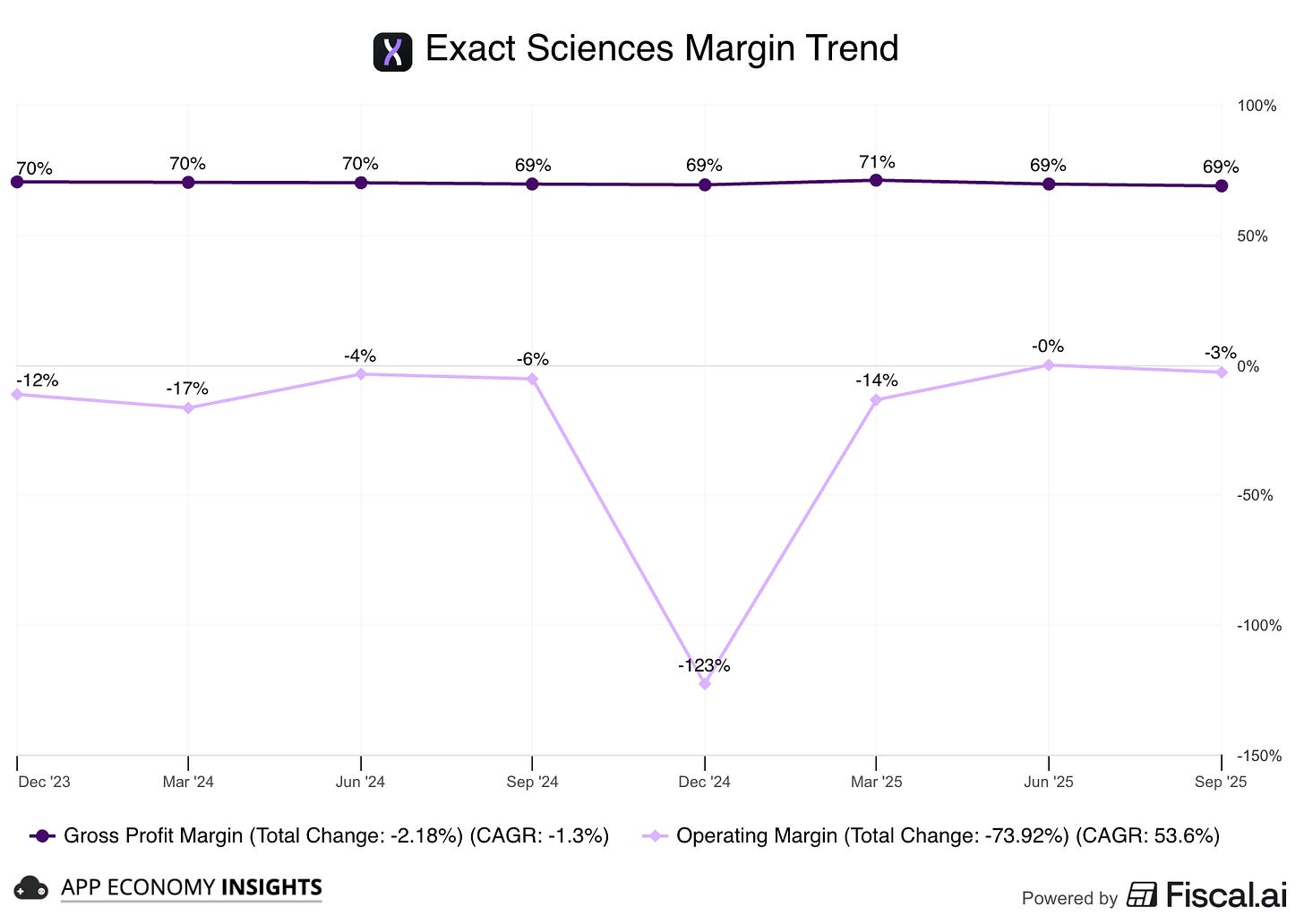
Why this matters
This deal fits a broader trend of healthcare incumbents buying proven products with reliable, repeatable demand rather than funding moonshot R&D from scratch.
Recent examples include:
Johnson & Johnson acquiring Shockwave Medical (~$13 billion) for high-growth cardiovascular devices.
Danaher acquiring Abcam (~$6 billion) to strengthen its antibody and reagent portfolio.
Thermo Fisher buying Olink (~$3 billion) to expand proteomics and biomarker capabilities.
In uncertain markets, incumbents buy certainty instead of chasing moonshots. Abbott itself has the balance sheet capacity for up to $30 billion in debt-funded M&A, thanks to low leverage and $7 billion in annual free cash flow.
📉 What’s Already Priced In?
AI skepticism has resurfaced in a big way. So much so that Michael Burry of “Big Short” fame launched a paid Substack arguing that NVIDIA is the new Cisco, or that US Big Tech is engaged in accounting fraud. Both are highly questionable claims, but they capture the moment.
As massive AI infrastructure commitments circulate through the market, including OpenAI’s multi‑year buildout, investors must answer a simple question: Who is actually on the hook for delivering all this compute? And how much of that future demand is already baked into today’s stock prices?
Public companies exposed to the AI supercycle are now being repriced based on execution risk. After all, if a stock surged on inflated expectations, the risk of a round trip is real.
A popular chart making the rounds on X this week was the stock price performance of the Google universe (including GOOG and AVGO due to Broadcom’s role in manufacturing Google’s TPU chips) compared to the OpenAI universe (NVDA, AMD, ORCL, MSFT, and CRVW benefiting from demand from the AI startup). The market keeps repricing based on the latest information available.
Oracle has been at the center of the biggest AI story of the year: OpenAI’s $1.4 trillion multi-year commitments. Few companies have tied their future to that wave as aggressively as Oracle.
The biggest backlog in software history
Oracle’s latest quarter showed a stunning $455 billion in remaining performance obligations (RPO). Management tied hundreds of billions of that to long-term AI cloud deals, with OpenAI front and center.

But here’s the nuance:
RPO is not cash.
RPO is not revenue.
RPO is not even demand.
It’s a mix of multi-year capacity agreements, partial non-cancellable commitments, and cloud reservations that reflect intent rather than realized consumption.
A 43% stock price drop reflects execution risk
Oracle’s stock price doubled from January to September, driven by the sheer scale of these AI commitments. Now the stock has fallen back to earth (down more than 40% in the past two months) as the market questions how much of this will convert, and how quickly.
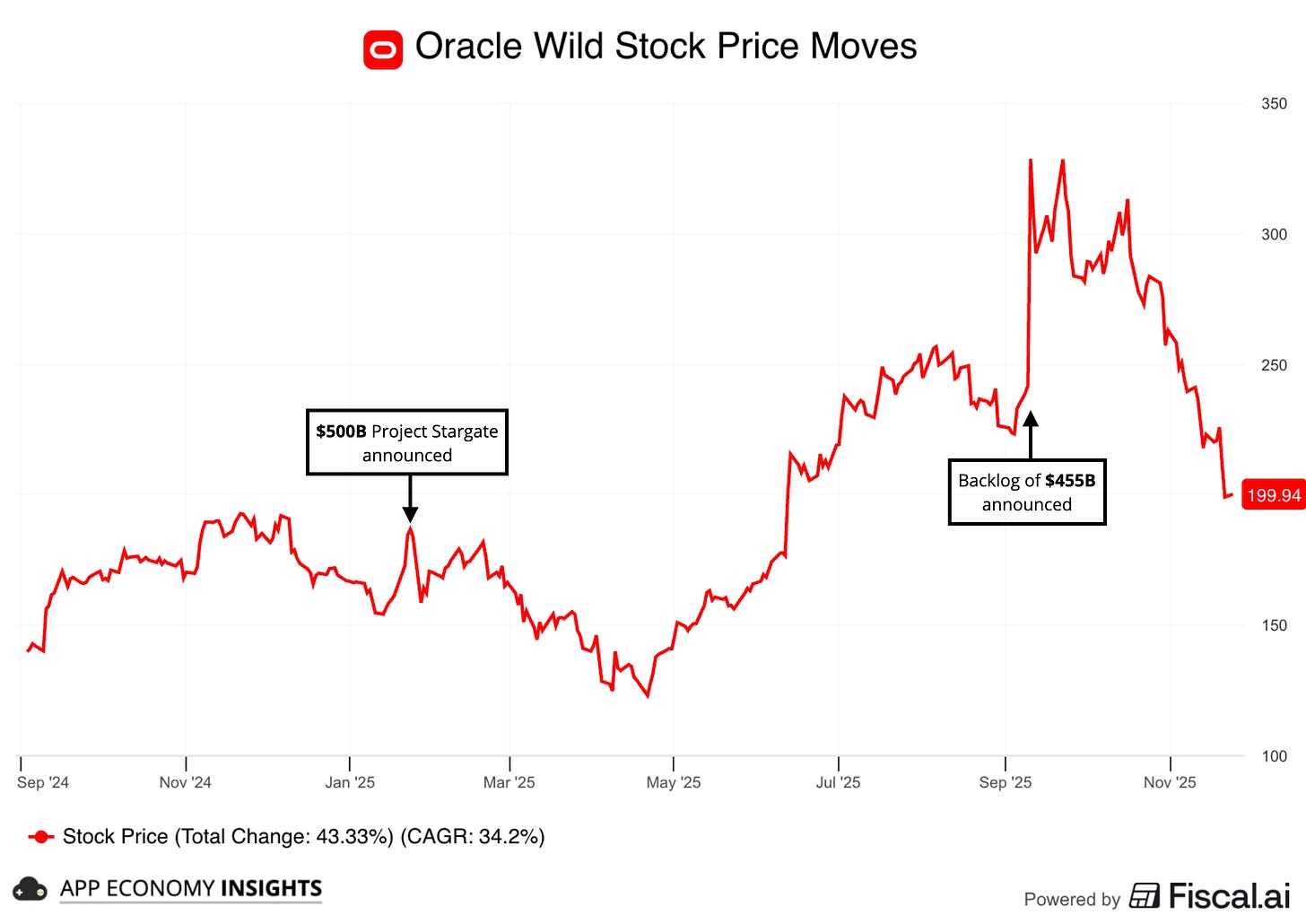
The massive backlog announcement came from Project Stargate, which was already well documented. You could argue the stock rally was never justified to begin with, since the size of the contract was already well known. But what matters now is that the market shaved off the entire spike, and then some.
In short, skepticism is reflected in the stock price.
The balance sheet is being stretched
Oracle is not like the rest of Big Tech. It’s investing ahead of hypothetical revenue. Unlike hyperscalers with massive existing free cash flow funding their AI buildouts, Oracle is leveraging up to finance a rapid global expansion of data centers.

Key pressures include:
Higher debt levels.
Capex rising faster than cash flow.
Tight financial flexibility compared to peers.
This works brilliantly if everything clicks, but it creates a real downside if it doesn’t.
How other hyperscalers approach AI demand
Microsoft, Amazon, Google, and Meta are funding AI infrastructure from strong balance sheets and operating cash flow. Demand is diversified across existing product lines like ad performance, enterprise cloud spend, government workloads, and SMB adoption.
Below is a 30,000-foot view of their annual free cash flow in the past decade, with the 2025 data as of September (trailing 12 months). And remember, free cash flow is already net of CapEx, so the impact of the so-called runaway spending is already baked into these numbers.

Their valuation is anchored on existing cash flow, not a hypothetical future. Amazon is an outlier in the chart above because the company is in perpetual ‘Day 1’ mode, reinvesting operating cash flow in new initiatives like Project Kuiper (low-earth satellites).
Could AWS, Azure, and Google Cloud see softer demand at some point if large AI startups fail to find product-market fit? Possibly. But if you are a regular reader of our earnings breakdowns, you know that many Enterprise customers are already seeing meaningful revenue growth from AI features. On the consumer side, Google and Meta have improved their products with AI (engagement, ad conversion), boosting revenue growth and margins.
Oracle, by contrast, has:
The biggest explicit AI-startup-related backlog.
The least balance sheet and cash flow flexibility.
The highest sensitivity to any slowdown in AI demand.
That’s why the market is going to treat AI exposure with different levels of scrutiny.
The takeaway
The AI supercycle is real. But when it comes to what’s priced in, investors are now focused on execution. Oracle’s latest round trip shows that the market has already adjusted some valuations, giving a premium to tangible earnings growth and looking at hypothetical long-term upside with caution.
And you know what? For a market that’s been deemed frothy for a while, a healthy sell-off in inflated stocks is just what the doctor ordered.
That’s it for today.
Happy investing!
Want to sponsor this newsletter? Get in touch here.
Thanks to Fiscal.ai for being our official data partner. Create your own charts and pull key metrics from 50,000+ companies directly on Fiscal.ai. Start an account for free and save 30% on paid plans this Black Friday with this link.
Disclosure: I own AAPL, AMD, GOOG, AMZN, META, and NVDA in App Economy Portfolio. I share my ratings (BUY, SELL, or HOLD) with App Economy Portfolio members.





